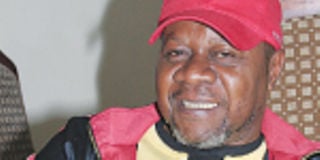Keeping tales of the man eaters of Tsavo alive in Kenyans’ minds

Maurice Wekesa Barasa, the new chief curator at the Nairobi Railway Museum, pulls open a desk drawer in his office and removes a container the size of a matchbox. Inside it are three lion claws.

“These are kept under lock and key,” he says. “This is our heritage, and we must protect it by all means.”
Mr Barasa then points out the glass case from which a European tourist removed the claws; they were later recovered in Tanzania where the thief had found a ready market for them.
The claws are of historical significance because they belonged to a famous lion, one of the two man-eaters of Tsavo that killed a young superintendent of police.
He had come out to Kenya to hunt down the animals that are said to have killed 140 people, most of them Indian labourers working on the Kenya-Uganda Railway.
While the claws are once again in government possession, the mounted remains of the lions are still in a museum in Chicago as a campaign is underway to have them returned to Kenya.
Return of the two
Gibson Shiraku is a member of the Return of Man-eaters of Tsavo Foundation whose mandate is to seek the return of the two lions from the Field Museum which bought their skulls and badly damaged hides for US$5,000 (about Sh325,000 at today’s exchange rates) from Lt. Col. John Henry Patterson, the chief engineer on the railway project in 1924.
By any standards, the man-eaters were deadly. British police Superintendent Charles Henry George Ryall was dragged from a first class railway wagon at night by one of the lions he had come to kill.
His skeleton was later recovered and brought to Nairobi’s All Saints Cathedral for a funeral service. He was buried in the War Memorial Cemetery.
Mr Shiraku’s father James Shiraku wa Inyundo, who had joined the railway in 1924, heard about the lions from a man who said he had witnessed the killing of Ryall.
On a wagon outside the railway museum is a plaque that reads: “It was from this wagon that Charles Henry Ryall was dragged and killed by a man-eating lion at Kima station on June 6, 1900.”
Inscribed on the wall at the entrance of All Saints Cathedral are the words: “In Memory of Charles Ryall, killed by a lion at Kima Station, June 6, 1900.”
Most church leaders and members pass it many times, ignorant of the significance of the inscription.
“The Chicago Field Museum should return our heritage. This is their home, and not America,” Mr Barasa said.
Mr Ryall, a 26-year-old British soldier, was one of three men who offered to hunt down the man-eaters that were mauling railways workers.
Accompanied by an Italian police officer named Parenti and Hubner, a German trader, Ryall arrived at Kima Station on June 5, 1900, where construction had come to a halt as the lions made sporadic attacks on workers.
Patterson, who killed one of the lions, later wrote ‘‘The Man-eaters of Tsavo,’’ published in 1907. Information about the incident was included in history lessons in Kenyan primary schools before the introduction of the 8-4-4 system of education in 1985.
But the remaining man-eater kept attacking, and Patterson engaged Ryall to kill it. As fate would have it, the hunter became the hunted and the last victim of the man-eaters.
The plaque on the wagon in the railway museum yard reads: “Ryall positioned himself on his bunk by the open window, gun in hand. Unfortunately he fell asleep. The lion padded in softly through the open door, grabbed him by his throat, and dragged him out of the carriage through a window. His companions were petrified and no one fired a shot. The lion disappeared into the darkness (with Ryall).”
Ryall’s funeral service was the only one held in a church for a victim of the man-eaters; he was described as a young man who demonstrated courage, love and dedication in the line of duty.
For Gibson Shiraku, there is a personal twist to the story. Talking to Lifestyle, he told of how his father had learned of the incident from Malkiat Gudwar Singh, one of the survivors of an attack, who showed him the grave of Charles Ryall.
His father in turn passed down the story to him when he was seven, and also showed him the grave. “When I grew up, my father gave me a 16-millimetre film which had been passed to him as a gift by Her Majesty’s Government in 1956,” Mr Shiraku said.
Transferring data
In 1985 he spent about Sh35,000, a very large amount of money at the time, transferring the film to video tape. He has since recorded it on VCD.
The documentary on the difficult conditions under which the railway was built shows how railway workers waded through thorny and thick forests, despite being attacked by wild animals and snakes. Sometimes torrents of rain disrupted work.
Meanwhile the US adopted the film and tailored it to ‘‘The Ghost and Darkness’’ following the wishes President Theodore Roosevelt, who thought the history was important. [This was later made into a movie starring veteran actor Michael Douglas and Val Kilmer. It was directed by Stephen Hopkins.]
Roosevelt visited Kenya in 1909 to follow up on the fascinating story of the man-eaters of Tsavo and to hunt at the same time. He couldn’t believe the story of the lions. He was a hunter himself. The story fascinated him.
Mr Shiraku remarked in an interview: “If only our youth watched this documentary, they would not uproot the railway as recently witnessed."
“The saddest part of it is that young men from as far as India and Britain offered their lives to come and build the railway, which we have not improved an inch for the last 100 years or more.”
American Shane Jett, a Republican Oklahoma state senator led a team of visitors last November to lay a wreath on Ryall’s grave and launch the Return the Man-Eaters of Tsavo Foundation.
“Indeed you have done proud the wishes of the late Theodore Roosevelt, America’s 26th President, whose desire was to maintain the history of Kenya, Uganda and man-eating lions on permanent record,” Jett said of the efforts to return the man-eaters.
Mr Jett had earlier visited the Chicago Museum and learnt that the lions belonged to Kenya. He developed interest in visiting Kenya to see the area where people were mauled by lions and at the same time visit the grave of a “hunter who turned the hunted”.
Mr Jett was accompanied by a team of officials of the Global Fusion Foundation, which helps communities in developing countries to partner with companies in the US to better their business.
While launching the foundation in Kenya, coincidentally, they attended a ceremony to put in public domain the Return the Man-Eaters of Tsavo Foundation.
Develop and preserved
Mr Jett and his team further sought to understand why President Roosevelt insisted that the story of the man-eaters of Tsavo be developed and preserved for future generations.
He came into contact with Mr Shiraku and when he went back home, he told the story of a foundation that was fighting for the return of the lions from the Chicago Museum.
Mr Jett says there was cause to request the return of the lions since Kenyan children need to possess them as their heritage. He says there were plans for talk show queen Oprah Winfrey to visit Kenya and lay a wreath on Ryall’s grave.
He explains that such a young man who offered himself for the sake of opening up East Africa by rail tragically died in the course of his duty. The grave would be turned into a tourist attraction centre, explains Mr Shiraku.
The Man-eaters of Tsavo reel is preserved in a museum at Martha’s Guest House in Butere, which is named after Gibson Shiraku’s mother. She and her husband Shiraku wa Inyundo were the owners of the building.
Photos obtained from Martha’s Guest House recently showed how rich the country’s cultural heritage was. They include a picture of Mzee Jomo Kenyatta, the founding father of the nation, sunbathing with, among others Dr Njoroge Mungai and Tom Mboya.
The construction of the railway began in March 1898 and within a few months the crew was building the Tsavo River Bridge where the lions caused them sleepless nights.
They tried to scare away the animals but in vain. Hundreds of workers fled the Tsavo, temporarily halting the construction.
Although it was believed that lions do not eat humans, two factors may have made the carnivorous animals to turn into eating human flesh – rinderpest disease had killed gazelles, zebras, waterbucks and other wilde beests, leaving lions without food.
The second theory was that the bodies of workers who had died of malaria were buried in shallow graves, making it easy for the lions to pull them out. They may then have got used to eating human flesh.
Every June 6, Mr Shiraku places a wreath on the grave of Ryall in his memory, and hopes that the lions in faraway Chicago will be returned soon.




